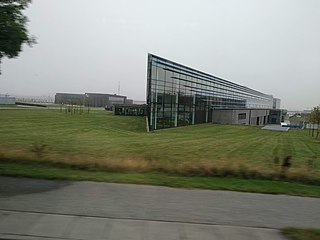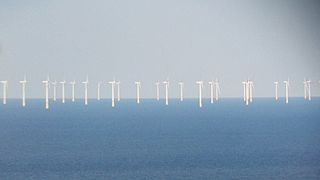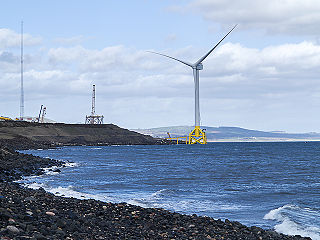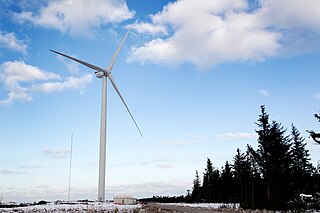
A wind farm or wind park, also called a wind power station or wind power plant, is a group of wind turbines in the same location used to produce electricity. Wind farms vary in size from a small number of turbines to several hundred wind turbines covering an extensive area. Wind farms can be either onshore or offshore.

Horns Rev is a shallow sandy reef of glacial deposits in the eastern North Sea, about 15 km (9.3 mi) off the westernmost point of Denmark, Blåvands Huk. The reef contains the Horns Rev Offshore Wind Farm.
Ørsted A/S is a Danish multinational power company based in Fredericia, Denmark. It is the largest energy company in Denmark. The company adopted its current name on 6 November 2017. It was previously known as DONG.

Vestas Wind Systems A/S is a Danish manufacturer, seller, installer, and servicer of wind turbines that was founded in 1945. The company operates manufacturing plants in Denmark, Germany, the Netherlands, Taiwan, India, Italy, Romania, the United Kingdom, Spain, Sweden, Norway, Australia, China, Brazil, Poland and the United States, and employs 29,000 people globally.

Gwynt y Môr is a 576-megawatt (MW) offshore wind farm located off the coast of Wales and is the fifth largest operating offshore windfarm in the world. The farm has 160 wind turbines of 150 metres (490 ft) tip height above mean sea level.

The Burbo Bank Offshore Wind Farm is a 348 MW offshore wind farm located on the Burbo Flats in Liverpool Bay on the west coast of the UK in the Irish Sea. It consists of an original 90 MW wind farm commissioned in 2007 and a 258 MW extension completed in 2017.

BARD Offshore 1 is a 400 megawatt (MW) North Sea offshore wind farm with 80 BARD 5.0 turbines. Since the owner could not buy such 5MW offshore wind turbines in sufficient numbers in 2006, Dr. Bekker set up its own production of turbines. This should serve as the legacy for his children. The systems were developed by aerodyn Energiesysteme GmbH. A plant for rotor blades and nacelle assembly was built in Emden and a plant for the offshore foundations in Cuxhaven. Two turbine prototypes were set up at the Rysumer Nacken in 2007, and another prototype in Hooksiel in 2008. Construction was finished in July 2013 and the wind farm was officially inaugurated in August 2013. The wind farm is located 100 kilometres (60 mi) northwest of the isle Borkum in 40-metre (130 ft) deep water.

Offshore wind power or offshore wind energy is the generation of electricity through wind farms in bodies of water, usually at sea. There are higher wind speeds offshore than on land, so offshore farms generate more electricity per amount of capacity installed. Offshore wind farms are also less controversial than those on land, as they have less impact on people and the landscape.

The Belwind Wind Farm is located on Bligh Bank, 46 kilometres (29 mi) from the Belgian port of Zeebrugge, and has been built in two phases. It has a 330 MW production capacity and an estimated annual output of 1.1 TWh. Phase 1 had a 165 MW production capacity.

Alpha Ventus Offshore Wind Park is Germany's first offshore wind farm. It is situated in the North Sea 45 kilometres (28 mi) north of the island of Borkum.

As of March 2023, wind power in the Netherlands has an installed capacity of 8,714 MW, 28.2% of which is based offshore. In 2019, the wind turbines provided the country with 12% of its electricity demand during the year, a figure that is growing but somewhat below the average of 15% that wind power provides across the whole of the EU's electricity consumption. The Dutch are trying to meet the EU-set target of producing 14% of total energy use from renewable sources by 2020, and 16% by 2023. Windmills have historically played a major part in the Netherlands by providing an alternative to water driven mills.
GE Wind Energy is a branch of GE Renewable Energy, a subsidiary of General Electric. The company manufactures and sells wind turbines to the international market. In 2018, GE was the fourth largest wind turbine manufacturer in the world.

Anholt Offshore Wind Farm is a Danish offshore wind power wind farm in the Kattegat, between Djursland and Anholt island. With a nameplate capacity of 400 megawatts (MW), it is one of the largest offshore wind farm in the world and was the largest in Denmark from 2013 to 2019. A cable from the wind farm to Anholt replaces most of the diesel-powered electricity on the island.

Walney Wind Farms are a group of offshore wind farms 9 miles (14 km) west of Walney Island off the coast of Cumbria, in the Irish Sea, England. The group, operated by Ørsted, consists of Walney Phase 1, Phase 2 and the Walney Extension. The extension has a capacity of 659 MW and it was the world's second largest offshore wind farm in 2018.

Methil Offshore Wind Turbine is a demonstrator site for experimental offshore wind turbines at Fife Energy Park off the coast of Methil, Fife in Scotland.

The Vestas V164 is a three-bladed offshore wind turbine, produced by Vestas, with a nameplate capacity of up to 10 megawatts, a world record. Vestas revealed the V164's design in 2011 with the first prototype unit operated at Østerild in northern Denmark in January 2014. The first industrial units were installed in 2016 at Burbo Bank, off the west coast of the United Kingdom. By 2021, Vestas had produced 500 of the series.

Horns Rev is an offshore wind farm in Danish waters in the North Sea.

Borssele Offshore Wind Farm is an offshore wind farm in the Dutch part of the North Sea, on the border with Belgium. It consists of 5 sites and 3 farms with a total capacity of 1502.5 MW.
















